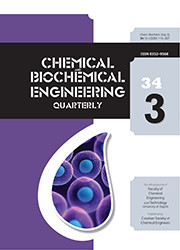All parts of the plantain are widely used in India for various purposes. But plantain leaf sheath always ends up as waste material which accumulates as a biowaste. The present study focuses on the preparation of activated carbon using phosphoric acid as activating agent, and its efficacy as an adsorbent for the removal of reactive dyes, Reactive Green 19, and Reactive Red 141. Batch adsorption studies have been conducted and optimum adsorption conditions were determined as a function of contact time, initial dye concentration, adsorbent dosage, and pH. The experimental data were analyzed using Langmuir, Freundlich and Temkin isotherm models. The pseudo-first and second-order, intraparticle diffusion, and Elovich models were used to analyze the kinetic parameters of the adsorption system. Under the optimum conditions (initial dye concentration = 200 mg L–1, adsorbent dose = 1 g, pH = 2, contact time = 220 min for reactive green 19 and 180 min for reactive red 141), maximum percentage removal for reactive green 19 and reactive red 141 were obtained as 65.9 % and 72.7 %, respectively. The results demonstrate that activated carbon produced from chemical activation of the plantain waste has the potential of adsorbing reactive dyes from industrial effluents.
Sažetak
Dio od

 Chemical & biochemical engineering quarterly : the international publication of "Kemija u industriji" : the official journal of Croatian Society of Chemical Engineers, Faculty of Chemical Engineering and Technology University of Zagreb, Slovenian Chemical Society, and Austrian Association of Bioprocess Technology : 34,3(2020) / co-editors-in-chief M. Rogošić, B. Zelić.
Chemical & biochemical engineering quarterly : the international publication of "Kemija u industriji" : the official journal of Croatian Society of Chemical Engineers, Faculty of Chemical Engineering and Technology University of Zagreb, Slovenian Chemical Society, and Austrian Association of Bioprocess Technology : 34,3(2020) / co-editors-in-chief M. Rogošić, B. Zelić.